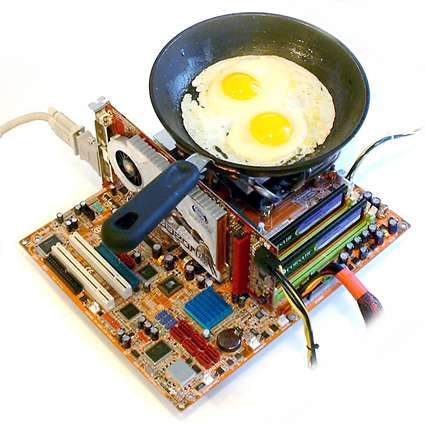Cheap Thrills: Core 2 Duo E6400 Overclocked to 3.33 GHz
Conclusion
We have to congratulate Universal Abit and Gigabyte, as the AB9-Pro and 3D Galaxy II combination brought us clock speeds far beyond our expectations, which were over 10% faster than what Intel's specifies for its fastest Core 2 Extreme X6800!
A quick look at the game benchmarks indicates that any increase in processor cost, including money spent on cooling in the pursuit of top clock speed, would be better spent on a top graphics card. We used relatively low resolutions, and increasing quality only serves to put even more bias on graphics power. Yes, the lowly Core 2 Duo E6400 appears to be "good enough" at stock speed to match nicely with an upper-midrange graphics card.
On the flip-side are processor-intensive applications such as audio and video conversion, where anything less than 3 GHz in the Core 2 Duo seems downright slow in comparison to overclocked numbers. But even then, the lowly E6400 got good numbers using stock cooling at "only" 3.1 GHz. Using DivX as the example, the performance difference between the E6400 at its max water cooled speed of 3,336 MHz and the E6700 at its max stock cooled speed of 3,460 MHz is only 3.5%....and the E6400 plus 3D Galaxy II combination is a full 30% cheaper!
The surprise here just may be that a $160 water cooler is actually a reasonable value for anyone who really needs the extra processing power. But those who can settle for just a little less performance will find ultimate value using the E6400 with Intel's retail-boxed cooler at a modest 3.1 GHz heat-imposed limit. We only wish we'd had an E6600 on hand to complete our value analysis.
Author's Opinion
Top performance and a productively quiet environment are often at odds with each other, and reaching the highest possible speed required each cooler to run at maximum fan speed. Rated at a moderate 35 db(A) at maximum speed, the Zalman CNPS9700 LED did well here, but performance to noise ratios would have caused me to stop somewhere around 3 GHz using automatic fan speed control. Its $70 price tag would be counted towards creating an ideal work environment.
On the water cooling front, I've cooked VRM transistors (MOSFET) using water cooling without the adding airflow over the voltage regulator, so I can appreciate Gigabyte's water block mounted VRM fan in spite of the mockery of onlookers who didn't fully appreciate its purpose.
Join our discussion on this topic
Get Tom's Hardware's best news and in-depth reviews, straight to your inbox.


